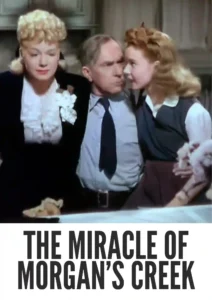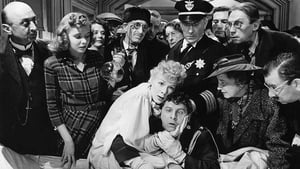Contact: info@alwanfilm.com
Video Sources 0 Views

Synopsis
The Miracle of Morgan’s Creek 1943 Colorized Review: A Hilarious Satire of Wartime America

Introduction
Released during the height of World War II, The Miracle of Morgan’s Creek (1943) stands out as one of the boldest and most innovative comedies of its era. Directed by the legendary Preston Sturges, this film pushes the boundaries of conventional Hollywood storytelling with its daring social satire and irreverent take on wartime morality. The film’s unique combination of slapstick humor, biting wit, and unconventional subject matter has solidified it as a classic in American cinema. In this review, we will explore the intricacies of The Miracle of Morgan’s Creek (1943), its impact on the genre of screwball comedy, and how its narrative and themes reflect the cultural climate of 1940s America.
Check The Full Colorized Movies List
Check Our Colorized Movies Trailer Channel
Understanding The Miracle of Morgan’s Creek 1943 Colorized: Director, Cast, and Genre
Preston Sturges’ Vision for The Miracle of Morgan’s Creek
Preston Sturges was a trailblazer in Hollywood, known for his razor-sharp scripts and unorthodox approach to filmmaking. As the writer and director of The Miracle of Morgan’s Creek, Sturges crafted a film that defied the norms of studio-era comedies. His vision was to create a satirical comedy that could cleverly navigate the censorship rules of the time while still addressing controversial topics like wartime romance, unintended pregnancy, and small-town conservatism.
Sturges’ direction is characterized by rapid-fire dialogue, chaotic plot twists, and a distinctive blend of realism and absurdity. His unique ability to balance these elements makes The Miracle of Morgan’s Creek an enduring masterpiece that continues to resonate with audiences.
The Iconic Performance of the Cast
The film stars Betty Hutton as Trudy Kockenlocker, a spirited and impulsive young woman whose wild night out leads to unexpected consequences. Hutton’s energetic performance brings a sense of vivacity and charm to the character of Trudy, making her both relatable and endearing despite her unconventional choices. Hutton’s comedic timing and expressive range perfectly capture Trudy’s mix of innocence, recklessness, and vulnerability.
Supporting Hutton is Eddie Bracken as Norval Jones, the bumbling and lovable suitor hopelessly infatuated with Trudy. Bracken’s portrayal of Norval is a masterclass in physical comedy, as he stumbles through increasingly outlandish situations with a mix of nervousness and sincerity. His character serves as the heart of the film, providing a foil to Trudy’s chaotic antics.
William Demarest, a frequent collaborator of Sturges, delivers a standout performance as Constable Kockenlocker, Trudy’s overprotective father. Demarest’s gruff yet comedic portrayal adds another layer of humor to the story, particularly in his exasperated attempts to manage the increasingly absurd situations surrounding his daughter.
Exploring the Screwball Comedy Genre
The Miracle of Morgan’s Creek fits squarely into the screwball comedy genre, which was characterized by rapid-paced dialogue, eccentric characters, and improbable situations. However, Sturges’ approach goes beyond the typical screwball formula, pushing the boundaries with its bold narrative choices and satirical undertones. The film’s subversive humor challenges societal norms, poking fun at the moral panic of the era and highlighting the hypocrisies of small-town America.
Exploring the World of The Miracle of Morgan’s Creek 1943 Colorized: Plot and Characters
Detailed Synopsis of the Storyline
Set in the fictional town of Morgan’s Creek, the film opens with Trudy Kockenlocker sneaking out to attend a farewell party for departing soldiers. After a night of heavy partying, Trudy wakes up the next morning with a foggy memory and a wedding ring on her finger, but no clear recollection of who her husband is—or even his name. To make matters worse, she soon discovers she’s pregnant.
Trudy turns to Norval Jones, her adoring but hapless childhood friend, to help her out of the predicament. Norval, who has been unsuccessfully trying to enlist in the army due to his poor health, sees this as an opportunity to prove his worth. He agrees to marry Trudy and pass the baby off as his own. However, a series of comically disastrous attempts to make their scheme work only lead to more complications.
As Trudy’s situation spirals further out of control, the town becomes embroiled in scandal, leading to a series of misunderstandings, arrests, and outrageous antics. The film culminates in a hilarious twist that turns the entire town on its head, as Trudy’s “miracle” pregnancy delivers a surprise that no one could have predicted.
Complex Protagonists and Memorable Supporting Characters
At the heart of the film are Trudy and Norval, two flawed yet lovable characters whose journey drives the story’s humor and emotional resonance. Trudy’s impulsiveness and Norval’s awkward earnestness create a dynamic that is both endearing and entertaining. Their relationship defies traditional romantic tropes, focusing instead on their loyalty and mutual affection amid the chaos.
Supporting characters, including Constable Kockenlocker and the various townsfolk, add to the film’s lively atmosphere. Each character is a caricature of small-town life, amplifying the absurdity of the narrative while offering sharp commentary on societal norms.
The Art of Satire in The Miracle of Morgan’s Creek 1943 Colorized
Sturges’ Approach to Satire
One of the most remarkable aspects of The Miracle of Morgan’s Creek is its satirical edge. Sturges uses the film to critique the moral standards of wartime America, subtly skewering the sanctity of marriage, the glorification of soldiers, and the pressures placed on women. His clever dialogue and situational comedy work in tandem to expose the absurdities of social expectations.
Through Trudy’s predicament, Sturges addresses the double standards women faced, particularly regarding sexuality and reputation. The film’s humor often serves as a mask for more serious criticisms, making it a powerful example of how satire can be used to navigate sensitive topics in a comedic context.
Blurring the Line Between Comedy and Social Commentary
Sturges’ genius lies in his ability to blend laugh-out-loud humor with incisive social commentary. The film’s plot, which revolves around a single night’s reckless decision, serves as a microcosm of broader societal issues. While audiences are entertained by the escalating series of comedic mishaps, they are also prompted to reflect on the cultural values being lampooned.
A Bold Narrative in Wartime Hollywood
Breaking the Rules of the Production Code
During the 1940s, Hollywood operated under the Hays Code, a set of strict censorship guidelines that dictated what could and could not be depicted on screen. Topics like premarital sex, pregnancy out of wedlock, and critiques of traditional values were considered taboo. However, Sturges cleverly circumvented these restrictions by cloaking his story in farce and satire.
The film’s playful approach allowed it to tackle risqué subject matter without directly violating the Code, and its success proved that audiences were ready for more daring and subversive storytelling. The Miracle of Morgan’s Creek was both a critical and commercial hit, demonstrating that there was room in Hollywood for films that pushed the envelope.
Reception and Impact on Censorship
Despite its unconventional plot, the film received positive reviews upon release. Critics praised Sturges’ sharp wit and the cast’s spirited performances. However, some conservative circles viewed the film as controversial, given its themes of accidental pregnancy and irreverent humor about sacred institutions like marriage and the military.
Nevertheless, the film’s success helped pave the way for more liberal interpretations of the Production Code in subsequent years, marking it as a significant milestone in the evolution of Hollywood censorship.
Influence and Legacy: The Miracle of Morgan’s Creek 1943 Colorized’s Impact on Cinema
Reinventing the Screwball Comedy
The Miracle of Morgan’s Creek stands as a turning point in the screwball comedy genre, setting a new standard for the blending of humor with social critique. Sturges’ work influenced many subsequent filmmakers, inspiring a wave of comedies that dared to address controversial topics with wit and irreverence.
The film’s impact can be seen in later works by directors such as Billy Wilder, who similarly employed dark humor and satire to comment on societal issues. Its legacy endures in contemporary comedies that continue to push boundaries and challenge audiences to think critically while laughing.
Director’s Cinematic Legacy: Beyond The Miracle of Morgan’s Creek 1943 Colorized
Preston Sturges’ Influence on Filmmaking
Preston Sturges is often regarded as one of the great pioneers of American comedy. His ability to write and direct his own films allowed him to infuse his projects with a distinct voice, characterized by rapid dialogue, eccentric characters, and a willingness to tackle unconventional subjects.
Sturges’ legacy extends far beyond The Miracle of Morgan’s Creek. His other classics, such as Sullivan’s Travels (1941) and The Lady Eve (1941), continue to be celebrated for their clever writing and innovative storytelling. Sturges’ influence is felt in the works of later comedic filmmakers, from the Coen Brothers to Wes Anderson, who draw on his mix of humor, satire, and humanism.
Themes Explored in The Miracle of Morgan’s Creek 1943 Colorized
The Intersection of Comedy and Social Critique
At its core, The Miracle of Morgan’s Creek explores themes of personal responsibility, societal expectations, and the often conflicting pressures of public and private morality. The film’s humor allows it to address these serious themes in a way that is both accessible and thought-provoking.
The character of Trudy embodies the struggles of women who were caught between societal norms and personal desires, a theme that resonates with modern audiences. The film’s portrayal of Norval’s unwavering support for Trudy, despite her mistakes, also challenges traditional gender roles, presenting a progressive take on relationships and loyalty.
Reception and Controversy Surrounding The Miracle of Morgan’s Creek 1943 Colorized
Critical Acclaim and Audience Reception
Critics lauded The Miracle of Morgan’s Creek for its originality and daring approach to comedy. Many praised Sturges’ ability to balance humor with sharp social commentary, while others highlighted the standout performances of Hutton and Bracken. The film was a box office success, solidifying Sturges’ reputation as a master of comedy.
However, its controversial subject matter did not go unnoticed. Some conservative groups decried the film’s lighthearted take on topics like premarital pregnancy, seeing it as undermining traditional values. Despite these criticisms, the film’s enduring popularity speaks to its ability to connect with audiences on multiple levels.
Where to Watch The Miracle of Morgan’s Creek 1943 Colorized Online
The Miracle of Morgan’s Creek is widely available on several streaming platforms, including Amazon Prime Video, Criterion Channel, and Turner Classic Movies. The film is also available on DVD and Blu-ray, often included in collections of Preston Sturges’ works, providing viewers with access to restored versions that capture the film’s original charm.
FAQs About The Miracle of Morgan’s Creek 1943 Colorized
Q: Why is The Miracle of Morgan’s Creek considered groundbreaking?
A: The film broke new ground with its daring narrative and satirical humor, challenging censorship norms and addressing controversial themes in a comedic context.
Q: Who are the main actors in The Miracle of Morgan’s Creek?
A: The film stars Betty Hutton as Trudy Kockenlocker and Eddie Bracken as Norval Jones, with standout support from William Demarest as Trudy’s father.
Q: What is the significance of the film’s title?
A: The title refers to the seemingly miraculous nature of the story’s resolution, where a series of improbable events lead to an unexpectedly positive outcome.
Q: How does the film address wartime themes?
A: The film uses humor and satire to critique wartime values, including the glorification of soldiers and the pressures placed on young women during the era.
Conclusion
The Miracle of Morgan’s Creek (1943) is a testament to the power of comedy to tackle serious social issues. Through its blend of humor, satire, and sharp commentary, Preston Sturges’ film challenges conventions and offers a timeless critique of societal norms. Its influence on the screwball comedy genre and its impact on censorship make it a pivotal work in the history of American cinema. Whether revisiting the film for its laughs or its deeper messages, The Miracle of Morgan’s Creek remains a must-see for fans of classic film and lovers of daring storytelling.












